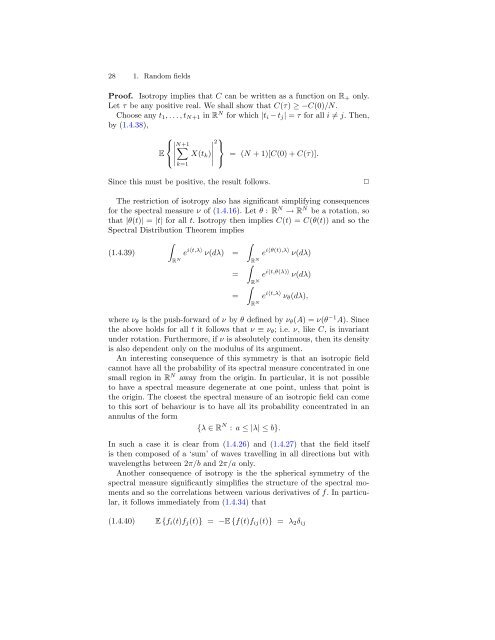Create successful ePaper yourself
Turn your PDF publications into a flip-book with our unique Google optimized e-Paper software.
28 1. Random fields<br />
Proof. Isotropy implies that C can be written as a function on R+ only.<br />
Let τ be any positive real. We shall show that C(τ) ≥ −C(0)/N.<br />
Choose any t1, . . . , tN+1 in R N for which |ti − tj| = τ for all i �= j. Then,<br />
by (1.4.38),<br />
⎧�<br />
�<br />
⎨�N+1<br />
2<br />
�<br />
� �<br />
�<br />
E � X(tk) �<br />
⎩�<br />
�<br />
⎫ ⎬<br />
= (N + 1)[C(0) + C(τ)].<br />
⎭<br />
k=1<br />
Since this must be positive, the result follows. ✷<br />
The restriction of isotropy also has significant simplifying consequences<br />
for the spectral measure ν of (1.4.16). Let θ : RN → RN be a rotation, so<br />
that |θ(t)| = |t| for all t. Isotropy then implies C(t) = C(θ(t)) and so the<br />
Spectral Distribution Theorem implies<br />
�<br />
RN e i〈t,λ〉 �<br />
ν(dλ) =<br />
RN e i〈θ(t),λ〉 (1.4.39)<br />
ν(dλ)<br />
�<br />
=<br />
RN e i〈t,θ(λ)〉 ν(dλ)<br />
�<br />
= e i〈t,λ〉 νθ(dλ),<br />
where νθ is the push-forward of ν by θ defined by νθ(A) = ν(θ −1 A). Since<br />
the above holds for all t it follows that ν ≡ νθ; i.e. ν, like C, is invariant<br />
under rotation. Furthermore, if ν is absolutely continuous, then its density<br />
is also dependent only on the modulus of its argument.<br />
An interesting consequence of this symmetry is that an isotropic field<br />
cannot have all the probability of its spectral measure concentrated in one<br />
small region in R N away from the origin. In particular, it is not possible<br />
to have a spectral measure degenerate at one point, unless that point is<br />
the origin. The closest the spectral measure of an isotropic field can come<br />
to this sort of behaviour is to have all its probability concentrated in an<br />
annulus of the form<br />
{λ ∈ R N : a ≤ |λ| ≤ b}.<br />
In such a case it is clear from (1.4.26) and (1.4.27) that the field itself<br />
is then composed of a ‘sum’ of waves travelling in all directions but with<br />
wavelengths between 2π/b and 2π/a only.<br />
Another consequence of isotropy is the the spherical symmetry of the<br />
spectral measure significantly simplifies the structure of the spectral moments<br />
and so the correlations between various derivatives of f. In particular,<br />
it follows immediately from (1.4.34) that<br />
(1.4.40)<br />
R N<br />
E {fi(t)fj(t)} = −E {f(t)fij(t)} = λ2δij
















